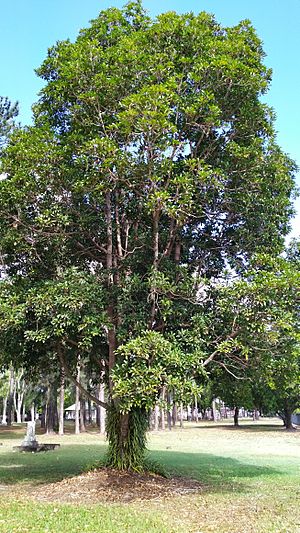Johnstone River almond facts for kids
Quick facts for kids Johnstone River almond |
|
|---|---|
 |
|
| Scientific classification | |
| Genus: |
Elaeocarpus
|
| Species: |
bancroftii
|
The Johnstone River almond (scientific name: Elaeocarpus bancroftii) is a special type of flowering tree found only in Queensland, Australia. It's also known by other names like Kuranda quandong or nut tree. This tree is known for its tough, leathery leaves that turn bright red before they fall off. It also produces interesting flowers and large, round fruits.
Contents
About the Johnstone River Almond Tree
The Johnstone River almond tree can grow very tall, up to 30 meters (about 100 feet)! Its trunk can be as wide as 60 centimeters (about 2 feet). It has a full, dark green leafy top.
Leaves, Flowers, and Fruit
The leaves of this tree are tough and leathery. They are usually about 8 to 13 centimeters (3 to 5 inches) long and 2.5 to 5 centimeters (1 to 2 inches) wide. Before they drop, these leaves turn a bright, fiery red.
The flowers have petals with three to five small points or "teeth" at their tips. Each flower also has many stamens, which are the parts that produce pollen. These flowers usually bloom from March to June.
After the flowers, the tree grows large, round fruits called drupes. These fruits are a dull grey-green color and are about 3 to 4 centimeters (1 to 1.5 inches) across. Inside each fruit is a single seed. This seed is protected by a very hard, thick inner shell called an endocarp.
Naming the Tree
The Johnstone River almond was first officially described in 1886. Two botanists, Ferdinand von Mueller and Frederick Manson Bailey, gave it its scientific name. They wrote about it in a publication called Proceedings of the Royal Society of Queensland. The plant samples they studied were collected near the Johnstone River by Thomas Lane Bancroft.
Where the Tree Grows
This tree is endemic to north-east Queensland, Australia. This means it grows naturally only in this part of the world. You can find it in thick rainforests. It grows from areas near Cooktown in the north, all the way south to about Tully. It can be found from areas close to the sea up to mountains about 1,200 meters (almost 4,000 feet) high.
Life in the Rainforest
The Johnstone River almond plays an important role in its rainforest home.
- Fallen fruits are a favorite food for large birds called cassowaries.
- Native rats, especially the giant white-tailed rat (Uromys caudimaculatus), also enjoy the seeds. They have to chew through the very hard shell to get to the tasty seed inside!
Conservation Status
Good news! The Queensland Government considers this tree to be of "least concern" for conservation. This means it is not currently at risk of disappearing.
How People Use the Tree
Traditional Uses
Aboriginal Australians used to eat the seeds of the Johnstone River almond. Because the shell is so hard, they needed to use special stones to crack them open. Sometimes, these "nut stones" were left right under the trees for future use.
Food for Settlers
An old book from 1889, called 'The Useful Native Plants of Australia', mentions that early settlers also ate the "kernels" (the inside part of the seed). They found them to have a good flavor.
Garden and Shade Tree
Today, the Johnstone River almond is sometimes sold as an ornamental tree. People plant it in gardens for its beauty or to provide shade.
Images for kids












